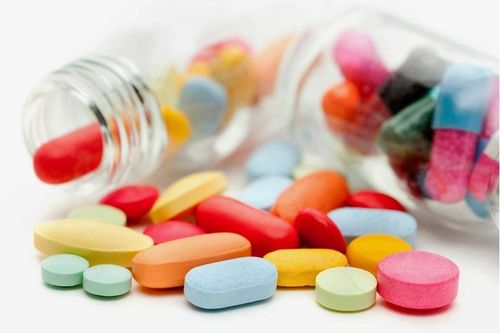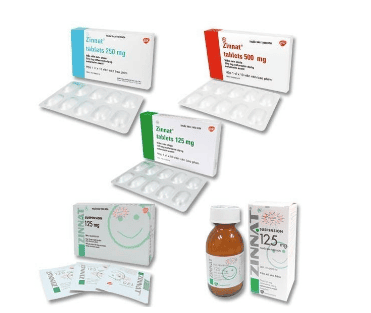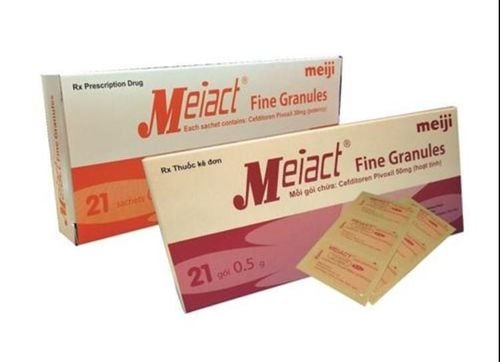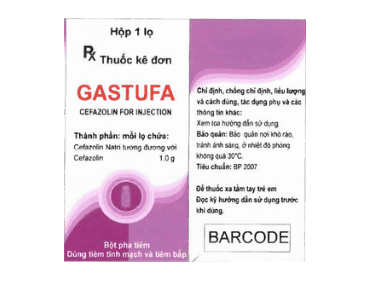This is an automatically translated article.
Sefonramide has the main ingredient is a cephalosporin antibiotic used to treat some bacterial infections such as meningitis, urinary tract infections, joint infections, pneumonia, sepsis...
1. What diseases does sefonramide treat?
What disease does sefonramide treat? Sefonramide has the main ingredient Ceftazidime (in the form of Ceftazidime pentahydrate) 1.0 g. The drug is prescribed by doctors to treat diseases such as:
Treatment of skin infections Bone and joint infections Abdominal infections Lower respiratory tract infections Urinary tract infections when the patient has or Uncomplicated Treatment of severe infections in immunocompromised patients Gynecological infections Central nervous system infections such as meningitis
2. Dosage and how to use Sefonramide
How to use: The drug is not absorbed from the gastrointestinal tract but is usually used for intravenous or intramuscular injection. The drug is usually injected into the upper quadrant of the buttocks or the lateral part of the thigh.
Solution for intramuscular injection: Dissolve Ceftazidime 1g in 3ml of distilled water for injection, 0.5% or 1% lilocaine hydrochloride solution can be used. Solution for infusion: Dilute Ceftazidime in 0.9% sodium chloride or 5% dextrose solutions but with a concentration of 10-20 mg/ml. Intravenous solution: Using the amount of Ceftazidime 1g mixed in 10ml of distilled water for injection can use 0.9% sodium chloride solution or 5% dextrose solution. Dosage:
The usual applied dose in adults is 1g every 8 hours or 2g every 12 hours, by intravenous or deep intramuscular infusion.
For patients with liver disease: No dosage adjustment is required.
For people with renal failure: Need to adjust according to creatinine clearance concentration, specifically as follows:
Creatinine clearance (ml/min) from 50-31 using a dose of 1 gram with a frequency of every 12 hours Clearance Creatinine clearance (ml/min) from 30-16 using a dose of 1 gram at a frequency of every 24 hours Creatinine clearance (ml/min) <5 using a dose of 500mg at a frequency of 48 hours. Children from 0 to 4 weeks old use 30mg/kg IV every 12 hours Children from 1 month to 12 years old use 30-50mg/kg IV up to 6g/ every 8 hours a day. For the elderly: The usual dose should not exceed 3g per day, especially patients over 70 years old.
Contraindications:
Do not use Sefonramide in patients with a history of shock when taking the drug. It is not recommended to use Sefonramide in patients who are allergic to cephalosporin antibiotics. Overdose and treatment:
Overdose: When taking too much of the drug Sefonramide can lead to neurological sequelae including convulsions, encephalopathy and coma. Treatment measures: If the reactions are mild, the doctor will prescribe symptomatic treatment. In more severe cases, serum ceftazidime concentrations can be reduced by hemodialysis.
3. Side effects when using the drug Sefonramide
The following are some undesirable reactions that patients may experience during drug treatment such as:
Effects on the stomach and intestines: Causes severe colitis with bloody stools, constipation, diarrhea, frequent thirst. If diarrhea occurs frequently, the patient should stop using the drug. Respiratory effects: With the use of cephalosporin antibiotics, the incidence of interstitial pneumonia with dyspnoea, cough, chest X-ray disturbances, eosinophilia, and PIE-reactive syndrome This is very rare. However, patients should not be subjective and need to monitor their health carefully, if they experience this reaction, they should stop using the drug and consult a doctor. Skin reactions: The incidence of this reaction is not much with symptoms including erythema, Lyell syndrome (toxic epidermal necrolysis), Stevens-Johnson syndrome. Central nervous system reactions include: Headache, dizziness, decreased taste, experience paresthesias, tremors, myoclonic jerks, convulsions and especially in patients with renal impairment who used ceftazidime without reducing the dose appropriately. at risk for encephalopathy. Shock reaction: This reaction is very rare, but the patient still needs to be cautious, when this reaction occurs, the patient should stop taking the drug and change to another treatment. Symptoms include abnormal taste, dizziness, tinnitus, tactile disturbances, stridor, sweating. Hypersensitivity reactions: Rash, urticaria, erythema, pruritus, flushing, erythema maculopapular, angioedema, anaphylactic reaction most marked by bronchospasm or hypotension. Patients need to stop taking the drug and change the treatment more suitable. Renal reactions: Severe impairment of renal function, including acute renal failure, therefore requires frequent monitoring of the patient. If any symptoms occur, it is necessary to stop the drug and consult a doctor for advice. Hematologic reactions: Causes leukopenia, hemolytic anemia, leukopenia, granulocytopenia, agranulocytosis, neutropenia, lymphocytosis, thrombocytopenia, anemia and increased eosinophils, thrombocytopenia. Vitamin deficiency: Possible reactions are vitamin K deficiency, such as hypoprothrombinemia, easy bleeding and vitamin B deficiency leading to other diseases such as glossitis, stomatitis, anorexia, neuritis. Other reactions such as: Pain and inflammation at the injection site, phlebitis or thrombophlebitis after intravenous administration.
4. Be careful when using the drug Sefonramide
Use caution in patients with a history of hypersensitivity to Ceftazidime, cephalosporins and penicillins. In patients with renal impairment: It should be noted that the total daily dose should be reduced in these patients. Taking the drug in high concentrations can cause neuromuscular excitability, convulsive reactions, encephalopathy, loss of balance. In patients with renal and hepatic impairment or in patients who are malnourished during treatment with Ceftazidime may reduce prothrombin activity. Use caution in patients with a history of gastrointestinal disease, especially dysentery. For pregnant women: Cephalosporins are considered to be quite safe to use during pregnancy. However, there are not enough clinical studies to confirm that the drug is used in this case. Therefore, the patient should only take the drug when necessary. For women who are breast-feeding: Ceftazidime is likely to be excreted in breast milk. Therefore, the drug should be used with caution in these cases.
5. Drug interactions
Possible drug interactions during use are as follows:
Abacavir: Ceftazidime may decrease the rate of excretion of Abacavir, which may lead to higher serum concentrations than Abciximab: Therapeutic efficacy of Abacavir. Abciximab may be reduced when used in combination with Ceftazidime. Aceclofenac, Acemetacin, Acyclovir: The risk or severity of nephrotoxicity may be increased when Ceftazidime is combined with these drugs. Acenocoumarol: Increases risk of bleeding reactions Acetaminophen: Ceftazidime may decrease the rate of excretion of Acetaminophen, leading to higher serum drug concentrations Acetazolamide: Acetazolamide may increase the rate of excretion of Ceftazidime, which may cause an increase in the excretion rate of Ceftazidime. may decrease serum drug concentrations and potentially decrease its effectiveness. Aldesleukin: Ceftazidime may decrease the rate of excretion of Aldesleukin, which may lead to higher serum concentrations of alendronic acid: The risk or severity of nephrotoxicity and hypocalcemia may be increased with Ceftazidime in combination with Alendronic acid Alteplase: The therapeutic efficacy of Alteplase may be reduced when used in combination with Ceftazidime Amiloride: Amiloride may increase the rate of excretion of Ceftazidime, which may decrease serum drug concentrations. and potentially reduce the effectiveness of Ampicillin: Ceftazidime may decrease the rate of excretion of Ampicillin, which may lead to higher serum concentrations Ancrod: The therapeutic efficacy of Ancrod may be reduced when used in combination with Ceftazidime Sefonramide drug has the main ingredient is a cephalosporin antibiotic used to treat certain bacterial infections. To ensure effective treatment and avoid unwanted side effects, patients need to strictly follow the instructions of the doctor, medical staff performing the infusion.
Follow Vinmec International General Hospital website to get more health, nutrition and beauty information to protect the health of yourself and your loved ones in your family.













